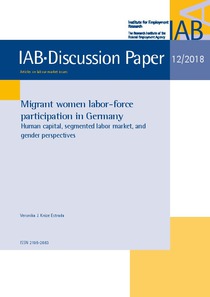Migrant women labor-force participation in Germany. Human capital, segmented labor market, and gender perspectives
"This paper analyzes individual, structural, and cultural factors that influence the labor-force participation of migrant women in Germany. Considering the well-established evidence that immigrant women work less than natives, with statuses and earnings differing significantly between them, I i...
| Main Author: | |
|---|---|
| Institution: | ETUI-European Trade Union Institute |
| Format: | TEXT |
| Language: | English |
| Published: |
Nürnberg
2018
IAB |
| Subjects: | |
| Online Access: | https://www.labourline.org/KENTIKA-19398889124911160619-Migrant-women-labor-force-part.htm |
| Summary: | "This paper analyzes individual, structural, and cultural factors that influence the labor-force participation of migrant women in Germany. Considering the well-established evidence that immigrant women work less than natives, with statuses and earnings differing significantly between them, I investigate the economic activity of the former by examining the cross-sectional data from the IAB-SOEP Migration Sample 2013 with multiple linear regression techniques. This evaluation is supported by three approaches which offer explanations for their employment behavior: human capital theory, segmented labor market theory, and the less examined in German research cultural hypothesis. Migrant women's employment status is, in principle, one's decision as member of a household; nevertheless, it is embedded in cross-national cultural processes and also constrained by structures; e.g., by employers and institutions. The analysis shows that classic human capital elements appear to be less reliable predictors of women's labor supply: higher education attained abroad is only marginally related to women participating in the workforce. The Middle-Eastern and North African origin, the Muslim religion, and higher levels of religiosity are negatively associated to women's labor participation reflecting a traditional gendered work division. This effect is minimized when controlling for German education, however. I argue that the lower labor-force participation among migrant women is partially explained by the fact that immigrants are on average less educated and more traditional than natives, having skills that are only restrictively transferable into the German labor market." |
|---|---|
| Physical Description: | 99 p. Digital |

